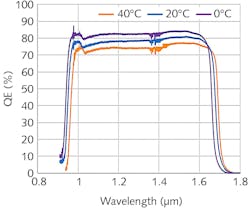Free-space optical (FSO) communications, which can transmit data at high speeds over long line-of-sight distances when optical fibers cannot be used (ground-to-aircraft, rapid-setup ground-to-ground links, etc.), must contend with problems, such as beam spread, that are not present in all-fiber communications. Perhaps the most difficult-to-deal-with problem of all for FSO is that of atmospheric turbulence, which causes beam scintillation (a random and often-large variation in received intensity due to varying optical power, tilt, and so on of the atmosphere in the beam path as it fluctuates).
Just as adaptive optics (AO) is used to greatly reduce the effects of atmospheric turbulence in astronomy, it can also be used for this purpose in FSO communications. However, FSO, which often operates in the shortwave-infrared (SWIR) region, suffers from the lack of fast SWIR cameras for AO wavefront sensors. Researchers from First Light Imaging (Meyreuil, France), Aix Marseille University (Marseille, France), and the University Grenoble Alpes (Grenoble, France) have remedied this problem by creating a 640 × 512 pixel SWIR camera that runs at 600 frames per second (fps), and has low size, weight, and power (SWaP) as well as low cost.
The researchers began with a visible-region camera for AO called OCam designed for laser guide-star astronomy applications, and created an infrared version using electron-initiated avalanche photodiode arrays (e-APDs) called C-RED One, which could operate at a 3.5 kHz frame rate and which became a commercial product. The group recreated the design as the C-RED 2 camera, based on indium gallium arsenide (InGaAs) SWIR detection, also for astronomy. Finally, the researchers slimmed the design down further by removing the active cooling and reducing the size of the electronics, producing the C-RED 3, suitable for portable FSO applications in the 1–1.6 µm wavelength region (see figure).
Frame-rate boost if needed
At 600 fps, the camera has a low dark-plus-readout noise of less than 50 e-, which for a FSO application means that most of the incoming laser light can go to the data detection rather than the AO. For certain FSO applications such as ground communication with low-earth-orbit satellites, the frame rate of the C-RED 3 camera can be boosted by using a subset of its pixels (4.8 kHz for 128 × 128 pixels and 9.5 kHz for 64 × 64 pixels—and even 32 kHz for a 32 × 4 pixel window). The camera, which has high-, medium-, and low-gain modes, has a linearity for these modes of better than 1%, 0.5%, and 0.5% respectively.
Use of the camera is not restricted to FSO applications, say the researchers—imaging systems for aircraft, including unmanned aerial vehicles (UAVs), are candidates for this device.
REFERENCE
1. J. L. Gach et al., arXiv:2001.05225v2 [physics.optics] (2020).

